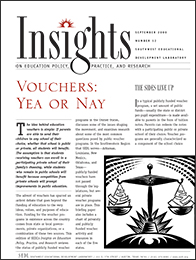The Sides Line Up
In a typical publicly funded voucher program, a set amount of public funds—usually the state or district per-pupil expenditure—is made available to parents in the form of tuition notes. Parents can redeem the notes with a participating public or private school of their choice. Voucher programs are generally characterized as a component of the school choice movement, along with such options as magnet schools, charter schools, home schools, tuition tax credits and deductions, and private voucher programs that states and communities are offering to open up more education options for students.
For their supporters, vouchers hold out an avenue of escape from failed public education systems. Proponents believe that public schools are doing a poor job of educating children because they have no competition built into them. The fact that private schools have to compete for students in a free market and are unencumbered by bureaucracies, unions, and unreasonable state rules and regulations makes them much more efficient at allocating educational resources than public schools. This, in turn, enables them to do a better job of educating students. Another argument is that vouchers give all parents, and especially poor ones, the same freedom to choose schools for their children as more affluent parents have had.
For their supporters, vouchers hold out an avenue of escape from failed public education systems.
For their opponents, vouchers undermine not only school reform but also the value of a common education experience to the nation. Opponents of vouchers assert that vouchers can never reach more than a few students but can do immense harm by siphoning off resources that otherwise could be used for teacher salaries, instructional materials, and other school improvements. The children who are most likely to be left behind are those who need attention the most—poor children whose parents are unable to be fully involved in their education. What’s more, voucher opponents maintain that competition is unlikely to improve public schools because public schools cannot function like the marketplace. Unlike owners of private businesses, teachers and principals do not control their own finances and therefore are not free to add resources to keep students from leaving. The best way to improve education, they believe, is to continue to strengthen public school reforms.
Both arguments have been around for a long time. The first voucher plan in this country was introduced by economist Milton Friedman in the mid-1950s and since then voters in some 20 states have weighed the pros and cons of this educational arrangement. Overwhelmingly, they have defeated voucher and tuition tax credit referenda. A 1999 poll conducted by the Gallup Organization for Phi Delta Kappa found that 70 percent of parents favored government efforts to improve public schools as opposed to offering vouchers (Holloway, 1999). To date only a handful of publicly funded voucher programs are in operation and some are the object of current litigation. None exist in Arkansas, Louisiana, New Mexico, Oklahoma, and Texas, but the idea still holds wide political appeal. Twenty-five state legislatures listed vouchers or other plans that use public dollars to fund private education on their legislative agendas during sessions in 2000 (Janofsky, 2000). In Michigan and California the question is slated to go before voters in November. In the Southwestern Region, some governors and state legislators are in various stages of advancing either voucher legislation or other alternatives that would ease the financial burden for parents who wish to send their children to private school (see chart on page 6). Although few measures made their way into law in the year 2000, vouchers are likely to reappear as an item on year 2001 legislative agendas.
Next Page: Where Are Public Voucher Programs Now?

